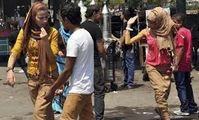SAKKARAH

Themastaba tombs
Ashas already been mentioned a mastaba is thetomb of a bobel or I dignitary built to resemble the house in which the deadperson formerly lived. The Sakkarah necropolis contains a considerable number ofmastabas, some of which are among the most renowned for their beauty and the gracefulness of their decoration. The Nebet mastaba, dating from the end of the Vth dynasty, is a typicalexample because of the rare style of decoration found in the second chamber.This shows the queen herself in the palace harem (the area reserved for the women)where she is witnessing the presentationof offerings while sniffing aflower.
The Visir Un-efert's mastaba on the other hand is Vlth dynasty. He isdepicted on a wall right at the entrance ofthe mastaba as an old man walkingtowards the interior of his sepulcher. The extant decoration in thePrincess Idut's mastaba is of particular interest. The mastabacontains ten rooms but onlyfive are decorated. One scene showstwo seated scribes intent on their work. The artist has been at pains toshow the case for their quills, the boxes for the colors and even the two sparebrushes which the scribe on the left has lodged above his ear. In the Kagemmimastaba are to be found tasteful and lively genre paintings. One quiteunusual scene depicted is of a servant pouring out bird-seed into an aviarywhile another shows a line of young girls engaged in an acrobatic dance.One the other side of the necropolis there is the mastaba of Ptah-Hotep, a high functionary of state, whose tomb is to that of his son Akhu-Hotep.This mastaba was discovered by the French archeologist Auguste Mariette whoarrived in Egypt in 1850.
The magnificent bas-reliefs, which can perhaps be attributed to a certainAnkgen-Ptah, allow us to see with a wealth of detail what daily life in ancientEgypt must have been like. We can see servants bringing offerings androwers in a boat whose gestures and movements resemble those of dancers.The most complex mastaba is that of Mereruka which was discovered in 1893and is subdivided into three parts. It consists in fact of quarters for theowner, who is also called Meri or Mera, for his wife the Princess Uatet-Khethor,who was also a priestess of Hathor, and for their children.
Itwas a mastaba appropriate to the rank of a person who like Mereruka had discharged variouspublic functions during the Vlthdynasty. Particularly original in its conception is the sceneshowing hunting and fishing, in which plants and animals are freely distributed all over theavailable space in a manner bordering on the fantastic. The mastaba of Ti is perhaps themost beautiful of all. It was already finished in 2600 B.C. when Cheops waspreparing to build his great pyramid.
Ti, the husband of the PrincessNefr-Hotep, lived during the Vth dynasty. Today we would describehim as a VIP, he as the director of all the Pharaoh's works, his close friend,his confidant, and the man in charge of building the pyramids or at least thisis how he is described in theinscriptions on the tomb. The bas-reliefs in the mastaba areconsidered to be among the most beautifulexamples from the period of the Old Kingdom both because of the high level ofartistic expression achieved and for the balance of theircomposition. Particularly noteworthyis the procession of womenelegantly carrying tall baskets on theirheads.
Your Rating:
Overall rating: 0.000
Totally voted: 0
Comments
Weather in:
Exchange Rates
-
IMF loan expected next month
Apr 22, 2013, rating: 3.000, 3 votes Egypt may secure an International Monetary Fund loan agreement in about amonth, state news agency MENA reported, quoting "informed" sources ...
Egypt may secure an International Monetary Fund loan agreement in about amonth, state news agency MENA reported, quoting "informed" sources ...
-
Egypt received 11 million tourists in 2012 and aims to boost that number to 14 million in 2013.
Jan 22, 2013, rating: 3.000, 2 votes
Egypt received 11 million tourists in 2012 and aims to boost that number to 14 million in 2013.
-
Egypt limits travelers leaving country to US$10,000 in cash
Dec 26, 2012, rating: 3.250, 4 votes Egypt has banned travelers from carrying more than US$10,000 in foreigncurrency cash in or out of the country ...
Egypt has banned travelers from carrying more than US$10,000 in foreigncurrency cash in or out of the country ...
-
National Coalition on Climate Change for Egypt is born
Nov 30, 2012, rating: 5.000, 1 votes The global COP18 conference on climate change opens in Doha Monday.About 17,000 participants from all over the world ...
The global COP18 conference on climate change opens in Doha Monday.About 17,000 participants from all over the world ...
-
Egyptian family's average annual income is LE25,000, agency reports.
Nov 29, 2012, rating: 5.000, 1 votes The average annual Egyptian household income during 2010-2011 wasLE25,353, according to the Central Agency for Public Mobilization andStatistics.
The average annual Egyptian household income during 2010-2011 wasLE25,353, according to the Central Agency for Public Mobilization andStatistics.
-
Judgment for sexual harassment
Nov 14, 2012, rating: 3.600, 5 votes A man was sentenced to two years in prison and fined LE 2,000 for sexually harassing a woman, an ...
A man was sentenced to two years in prison and fined LE 2,000 for sexually harassing a woman, an ...








